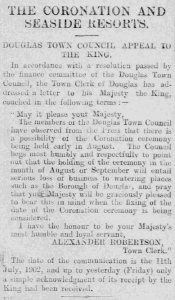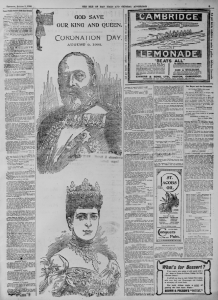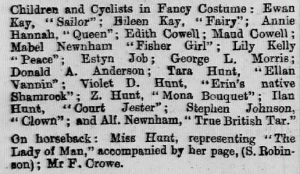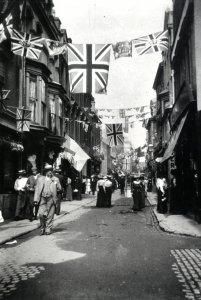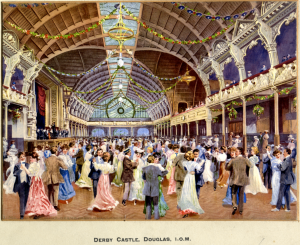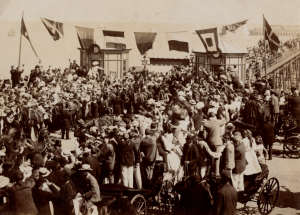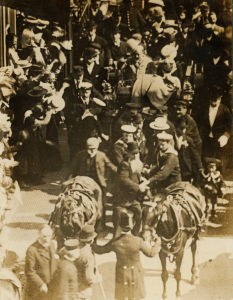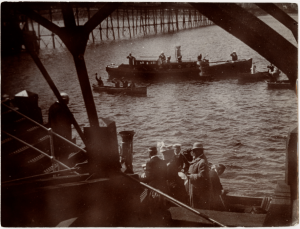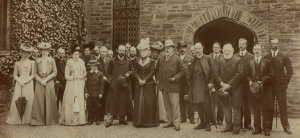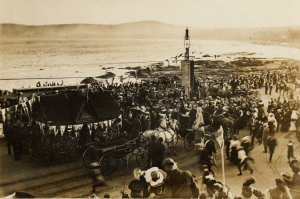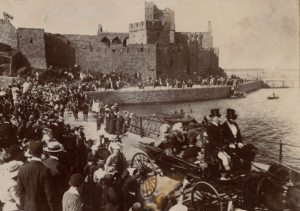Edward VII’s Coronation Day in the Isle of Man (9 August 1902)
King Edward VII and Queen Alexandra were to be crowned at Westminster Abbey on 26 June 1902. Shockingly, a few days before the Coronation, Edward suffered a life-threatening appendicitis which meant it was cancelled. With the King’s health still in the balance, the finance committee of Douglas Town Council was worried – not about arrangements to crown its Sovereign – but about the impact of any rescheduled Coronation Day on the island’s holiday trade. It wasted no time in writing to the Palace,
“May it please your Majesty, The members of the Douglas Town Council have observed from the Press that there is a possibility of the Coronation ceremony being held early in August. The Council begs most humbly and respectfully to point out that the holding of the ceremony in the month of August or September will entail serious loss of business to watering places such as the Borough of Douglas, and pray that your Majesty will be graciously pleased to bear this in mind when the fixing of the date of the Coronation ceremony is being considered.” (Isle of Man Examiner, 26 July 1902, p.7)
Poster for the ‘original’ Coronation of King Edward VII and Queen Alexandra on 26 June 1902 © Manx National Heritage (P.6664)
Edward VII and Queen Alexandra were crowned at Westminster Abbey on 9 August 1902 in flagrant disregard of Douglas Town Council. The Isle of Man Times was less than optimistic about the scale of Coronation Day celebrations in the Isle of Man,
“Celebrations on a more or less elaborate scale will be held in different parts of the Island, though those parishes who have already held demonstrations will, in all probability, not do much. Saturday, being market day, is a most busy day with all classes in the Island, so that comparatively few persons will be able to take part in the demonstrations.” (Isle of Man Times, 9 August 1902, p.7)
Douglas Town Council’s letter to the King, re-printed in the Isle of Man Examiner, 26 July 1902, p.7
Processions and lights for the Coronation did happen in Douglas and elsewhere on 26 June which crowds attended for the sake of ceremony more than any joyous occasion given the King’s perilous state,
“On June 26th all the houses along the front of the bay were brightly lit up, every window round the whole circule having its row of candles; but on that occasion the bonfires, fireworks, and official illuminations were postponed as being improper considering the serious condition of the King.” (Isle of Man Times, 16 August 1902, p.5)
Saturday 9 August was “invitation to mark the actual crowning of the King” (Manx Sun, 16 August 1902. p.2) despite the distraction of market day. With the King and Queen crowned and the King’s health fully recovered, the day was a lively and noisy affair,
“When the news of the Coronation having taken place reached Douglas, which it did about 12-40, a salute was fired from the Lifeboat Station.” (Manx Sun, 16 August 1902, p.2)
At the Coronation in Westminster Abbey were representatives from the Isle of Man,
“Sir James Gell, the Acting Governor, and Mr A.W. Moore, Speaker of the House of Keys, were, by special invitation of the Earl Marshall, present at the Coronation ceremony in Westminster Abbey on Saturday last. They had capital seats, and describe the ceremony as ‘indescribably impressive.'”(Manx Sun, 16 August 1902, p.4)
Isle of Man Times, 9 August 1902, p.5
Peel held its Coronation ceremony two days later on Monday with the planting of an oak tree. (Earlier in the day a twenty-one gun salute from a nine-pounder in front of the Creg Malin Hotel was “performed to the great interest of a great crowd of visitors.”) The tree, hopeful symbol of a long and happy reign, was planted in the grounds of the Court House before an audience of children to whom the High-Bailiff gave this address,
“Children of Peel I have a few words to say to you direct from His Majesty the King (hear, hear)…His Majesty the King has signified his approval to a scheme whereby a young oak tree is to be planted in Peel (amongst other places) on the day of his coronation. This tree is only a small one now, but in the days to come it will over-shadow all this place when you and I have gone to the places assigned to us…the King is anxious that the children of Peel shall be present here that they may know the love the King has for his people, and on this occasion especially for the people of Peel. I am now going to ask my good wife to plant the tree, and I am sure you will agree with me that it could not be well planted by a better woman (hear, hear and applause). I quite agree with you, except Miss Joughin (laughter), and she refused to do it. Now my friends this is the inauguration of our Coronation day. It begins by planting this oak tree, which when I am gone and a lot of you will be living, you will be able to say, ‘I remember the day when the poor old High-Bailiff made a speech, and when his good wife planted that tree with great grace’ (laughter). I will now ask Mrs Laughton to be good enough to plant the tree (loud applause).” (Peel City Guardian, 16 August 1902, p.3)
With an eye on the future the High-Bailiff added,
“Boys, you will take care of this tree and protect it in days to come. You girls, when you have married suitable husbands, you will come on your honeymoons and sit under this tree, and say this is the tree for Peel (laughter).” (Peel City Guardian, 16 August 1902, p.3)
Peel put on a gay procession “the shopkeepers having closed their places of business at one o’clock”. 1,100 children and “cyclists in fancy costume” paraded through the town, watched by thousands of people along the route many of them holiday visitors. The Castle ferry boats were kept busy as 2,500 persons were given free admission to Peel Castle. Once inside and sat on the grass,
“The first point of procedure was to satisfy the vigorous appetites of the children, and with this object in view there was a liberal supply of ginger beer and other sweet and nonintoxicating drinkables. The children were likewise presented with handsome ‘Coronation’ mugs on the outside of which was a coloured representation of the King and Queen. It is regrettable that there was not a sufficient supply of these, over 100 children being without. The mugs were utilised in getting rid of the ginger beer and judging by the quantity which some of the greedier ones consumed the chemists must have had a busy time next day. In the way of solids each child was given a large bag of buns, and these as rapidly disappeared as the ‘pop.'” (Peel City Guardian, 16 August 1902, p.3)
At nine o’clock in the evening the signal gun was fired from the Rocket House and promptly “house-holders illuminated their houses by placing candles in the windows” (Mona’s Herald, 13 August 1902, p.7). The Peel City Guardian praised its populace, visitors, and dogs,
“…the townspeople rose to the occasion, and, as if to make amends for a delayed event, made the day a memorable one in the annals of the ‘city.’ Unfortunately the weather was not of the best, but it kept fine enough to allow a full programme being carried out…Even the dogs wore ribbons of patriotic hues.” (Peel City Guardian, 16 August 1902, p.3)
Fancy dress at Peel, (Peel City Guardian, 16 August 1902, p.3)
Peel City Guardian, 16 August 1902, p.2
In nearby Patrick the generosity of two men saw everyone in the parish invited to a free tea,
“The celebration at Patrick was on a more generous scale than any of the other local celebrations, as between the Captain of the Parish (Col. Anderson) and Mr A.S. Collard, of Liverpool (‘an old Patrick boy’) practically all the expense was met, and not only the were the children feted but there was a free tea, of which every adult in the parish was invited to partake…between twelve and fourteen hundred persons sat down to the free tea, in addition to the three hundred children who were supplied…Naturally the feeding of such a multitude of persons took some time, one table having no less than fourteen sittings.” (Peel City Guardian, 16 August 1902, p.3)
At the end of the tea “80lbs of sweets were distributed amongst the children by Colonel Anderson” (Peel City Guardian, 16 August 1902, p.3). In Port Erin in preference to gobbling sweets goblets were the free give-a-way,
“…a presentation to all children, both visitors and residents, of a handsome goblet will be made in commemoration of the Coronation of King Edward VII. The presentation will be made on the Golf Links. The Crosby Brass Band will be in attendance.” (Manx Sun, 9 August 1902, p.8)
Over in Santon the more strenuous pastime of tug-of-war, “married men v. single”, was underway. “After two tugs the single men won” (Mona’s Herald, 13 August 1902, p.7). In Castletown it was ropes of a different kind that set the church bells going as “guns and rockets were fired from the Pier by the coastguards” on Saturday’s Coronation Day (Mona’s Herald, 13 August 1902, p.7). Fireworks were sent shooting into the sky from the top of Castle Rushen and it was the Castle which formed the focus of the address sent from Castletown to Edward VII and Queen Alexandra who was Danish,
“To their Most Gracious Majesties, King Edward VII and Queen Alexandra…In this Kingdom of Man, we feel peculiar interest in addressing your Majesty the Queen, inasmuch as our ancient history is so closely connected with that of Denmark, our Island having been long ruled by a race of Scandinavian Kings, to whom we are indebted for many of the constitutional privileges which we enjoy; and in this town we have a noble monument of their rule – the ancient Castle of Rushen.” (Mona’s Herald, 13 August 1902, p.7)
Procession in Douglas for the ‘original’ Coronation of King Edward VII and Queen Alexandra on 26 June 1902 © Manx National Heritage (PG/0817)
Douglas on Saturday 9 August, notwithstanding having held a Coronation procession on 26 June, wore its brightest Coronation apparel. Noticeable was the abundance of flags and streamers some put to new use possibly from the Boer War celebrations earlier that year. Whilst the lawyers in Athol Street made “some very effective drapings” (Mona’s Herald, 13 August 1902, p.7) Strand Street was the most ablaze with colour,
“Throughout the day, in earnest of their loyalty, many hundreds of householders and shop-keepers decorated their premises with flags and streamers. Of streets, Strand Street easily carried off the decorative honours. Flags floated from almost every house, and were hung across the street in lines of various heights, making a long vista of brightest colours. In the evening, this busy thoroughfare was thronged with sightseers.” (Mona’s Herald, 13 August 1902, p.7)
All that day the trams provided the town and its visitors with a loyal and colourful procession,
“The tramway officials had made very successful efforts to beautify the appearance of the cars, which added greatly to the festive appearance as they ran along the streets with miniature Union Jacks flying, and bearing other gay devices.” (Manx Sun, 16 August 1902, p.2)
Strand Street, Douglas, 1902 © Manx National Heritage (PG/13607/3/03)
At night it was the turn of bonfires, gas lights and single candles in windows to delight townsfolk and visitor alike. Huge fires were lit on Douglas Head and Bank’s Howe which “threw a shaft of golden light full across the bay” which only added to the usual summer illuminations of Douglas Bay and the score of illuminated hotels along the Promenade, “whilst in the background, Osborne Terrace shone out as a brilliant tiara” (Mona’s Herald, 13 August 1902, p.7). Crowds marvelled at vessels in the bay bedecked with “great bright lights” and the display of coloured of fire made on the Tower of Refuge. One fire failed to ignite,
“It was intended by the Coronation Committee to have had an old hulk set ablaze in the bay, as a finale to the night’s proceedings. The hulk was prepared for the occasion, being laden with tar barrels, and other combustible material, and had this part of the programme been carried out, it would have proved an effective ending; but, by somebody’s blundering, the hulk remained high and dry in Douglas harbour.” (Mona’s Herald, 13 August 1902, p.7)
More successful were the “devices in gas jets” on the frontage of Parr’s Bank,
“From one side to the other ran the words “Edward – Alexandra,’ in huge letters three or four feet high, and there were also a crown and the Royal initials, and the Prince of Wales’ feathers enclosed in a star. To supply these thousands of burners a special pipe had been attached to the main.” (Manx Sun, 16 August 1902, p.2)
A lady visitor to the island was so impressed by the illuminations in Douglas and by one street in particular, she felt compelled to write a letter of congratulation to the newspaper,
“It was pleasant to see the gay aspect of the town last Saturday. Looking down Strand Street, one’s eyes were dazzled by the fluttering flags overhead – the very narrowness of the street enhancing the effect. But although separate private houses were bright and gay, there was only one terrace, where anything like a design was carried out and the result was really remarkable. I speak, of course, of Osborne Terrace; I believe the householders came to an arrangement to illuminate their houses on the same plan, and achieved thereby a notable success. The balconies were studded with fairy lamps; large Chinese lanterns were suspended below, and on the gates; and the windows behind literally blazed with light.” (Manx Sun, 16 August 1902, p.2)
“The audiences at The Palace, The Palace Opera House, Derby Castle, the Grand and the Gaiety Theatres sang ‘God save the King’ before the performances were begun, and the effect of such numbers of people joining whole-heartedly in singing was extremely fine. It was not until a late hour that the streets became quiet.” (Manx Sun, 16 August, 1902 p.2). Image: Derby Castle, Douglas © Manx National Heritage (P.2757)
In July 1902 Douglas Town Council had been worried about the “serious loss of business” to a seaside resort like itself if the Coronation Day was rescheduled to happen in August. It needn’t have worried. Visitors to the boarding houses saw the Coronation as just another holiday memory to cherish. Visitors “actively interested themselves in decorating their temporary abodes” (Isle of Man Times, 16 August 1902, p.5) and for at least two visitors the early hours of Coronation Day 9 August 1902 were a wonderful patriotic blur,
“Before the High-Bailiff, on Saturday morning, two respectably dressed young men, who said they were visitors, were charged with disorderly conduct. It appears that in the early hours of the morning the young men sat on the Promenade wall singing “God save the King.” They made a fearful row, considering the hour, judging from the statement of a constable who marched them off to Athol-street. The High-Bailiff came on the bench in good humour, and after scanning the culprits critically, said he thought the simplest way would be, now that we were in peace and quietness with the all the world, to have peace here, and that he should send the men about their business. He added: ‘It is Coronation Day, and I don’t want to punish anyone; but see that you behave yourselves during the remainder of your stay. You would have been sent to gaol for three months if it had not been Coronation Day. (Laughter.)” (Manx Sun, 16 August 1902, p.16)
Postscript. King Edward VII and Queen Alexandra visited the Isle of Man only sixteen days after their Coronation on 25 August 1902, landing and departing from the Queen’s Pier, Ramsey. Below is a selection of photographs taken from the Manx National Heritage Library and Archives of their day spent touring the Isle of Man.
Edward VII to Ramsey, 25 August 1902 © Manx National Heritage (PG/4093)
Edward VII to Ramsey, 25 August 1902 © Manx National Heritage (PG/4096)
Edward VII to Ramsey, 25 August 1902 © Manx National Heritage (PG/4094)
Edward VII and Queen Alexandra, 25 August 1902 © Manx National Heritage (PG/0557)
Edward VII visit to Douglas, 25 August 1902 © Manx National Heritage (PG/4097)
Edward VII visit to Peel, 25 August 1902 © Manx National Heritage (PG/6717)
Edward VII’s Coronation Day in the Isle of Man is part of ‘Coronation Days Past in the Isle of Man’, stories re-told from the island’s historic newspapers cared for by Manx National Heritage, the charity responsible for the Isle of Man’s natural and cultural heritage.
Join us next week for the final Coronation story in this series from the island’s newspapers.
Visit coronation.gov.im
Jude Dicken, Collections Information Manager, Manx National Heritage
Blog Archive
- Edward VII’s Coronation Day in the Isle of Man (9 August 1902)
- Victoria’s Coronation Day in the Isle of Man (28 June 1838)
- Second World War Internment Museum Collections
- First World War Internment Museum Collections
- Rushen Camp: Second World War Internment on the Isle of Man
- Hutchinson, Onchan & Peveril Camps: Second World War Internment on the Isle of Man
- Douglas Promenade: Second World War Internment on the Isle of Man
- Mooragh Camp: Second World War Internment on the Isle of Man
- Sculpture collection newly released to iMuseum
- Fishing Folklore: how to stay safe & how to be lucky at sea
- News from the gaol registers project: remembering the men and women who served time in Castle Rushen
- Explore Mann at War: stories of Manx men, women and children in conflict
- We Will Remember Them: Isle of Man Great War Roll of Honour (1914-1918)
- Dr Dave Burnett explores Manx National Heritage geology collection
- Unlocking stories from the Archives: The Transvaal Manx Association
- Login to newspapers online: step-by-step guidance
- ‘Round Mounds’ Investigation Reveals Rare Bronze Age Object


